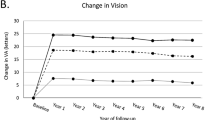Abstract
Purpose
Since atherosclerosis contributes to the pathophysiology of retinal vein occlusion (RVO), we aimed to assess the effects of aspirin and statins on the visual outcomes of RVO in high-risk patients, whom we define to have hypertension and open-angle glaucoma prior to RVO.
Methods
We conducted a retrospective case–control study of adults diagnosed with RVO between 2006 and 2014. To evaluate for a preventive effect of these medications, we compared the prevalence of aspirin or statin use (either separately or concomitantly) among high-risk patients who developed RVO and among those who did not during at least 2 years of follow-up. To evaluate for a therapeutic effect, we then compared the final follow-up visual acuity (VA) of high-risk RVO patients who had and who had not been taking a statin prior to the RVO.
Results
We analyzed 43 eyes [23 central RVOs (CRVOs), 16 branch RVOs (BRVOs), and 4 hemi-RVOs (HRVOs)] from 42 high-risk patients, along with 129 high-risk controls. There was no significant difference (p = 0.47) in aspirin exposure between the control (60%) and RVO (67%) groups, and the increased statin exposure among controls (72% vs. 53% for the cases; p = 0.03) paralleled their higher prevalence of hyperlipidemia. The non-statin and statin RVO groups each had a mean VA of 20/800 at a mean 30 and 43 months of follow-up, respectively.
Conclusions
No preventive benefit of aspirin or statins, and no therapeutic benefit of statins, was found for RVO in high-risk patients. High-risk RVO patients suffer substantially worse outcomes than those reported in other studies not limited to such patients.
Similar content being viewed by others
References
Yuan A, Kaiser PK (2012) Chapter 53, Branch vein occlusion. In: Ryan SJ, Schachat AP, Wilkinson CP, et al. (ed) Retina, 5th edn. Saunders, Philadelphia, pp 1029–1038
Hahn P, Mruthyunjaya P, Fekrat S (2012) Chapter 54, Central vein occlusion. In: Ryan SJ, Schachat AP, Wilkinson CP, et al. (ed) Retina, 5th edn. Saunders, Philadelphia, pp 1039–1049
Klein R, Klein BE, Moss SE et al (2000) The epidemiology of retinal vein occlusion: the Beaver Dam Eye Study. Trans Am Ophthalmol Soc 98:133–143
Hayreh SS, Zimmerman MB (2012) Hemicentral retinal vein occlusion: natural history of visual outcome. Retina 32:68–76
Janssen MC, den Heijer M, Cruysberg JR et al (2005) Retinal vein occlusion: a form of venous thrombosis or a complication of atherosclerosis? A meta-analysis of thrombophilic factors. Thromb Haemost 93:1021–6
Williamson TH (1997) Central retinal vein occlusion: what’s the story? Br J Ophthalmol 81:698–704
Karia N (2010) Retinal vein occlusions: pathophysiology and treatment options. Clin Ophthalmol 4:809–816
Hayreh SS, Podhajsky PA, Zimmerman MB (2011) Central and hemi-central retinal vein occlusion: role of anti-platelet aggregation agents and anticoagulant. Ophthalmology 118:1603–1611
Mihos CG, Salas MJ, Santana O (2010) The pleiotropic effects of hydroxy-methyl-glutaryl-CoA reductase inhibitors in cardiovascular disease: a comprehensive review. Cardiol Rev 18:298–304
Jaulim A, Ahmed B, Kanam T et al (2013) Branch retinal vein occlusion: epidemiology, pathogenesis, risk factors, clinical features, diagnosis, and complications. An update of the literature. Retina 33:901–910
Glacet-Bernard A, Coscas G, Chabanel A et al (1996) Prognostic factors for retinal vein occlusion: a prospective study of 175 cases. Ophthalmology 103:551–560
Grosso A, Cheung N, Veglio F et al (2011) Similarities and differences in early retinal phenotypes in hypertension and diabetes. J Hypertens 29:1667–75
Glaziou P (2005) SampSize. Sampsize.sourceforge.net. Accessed 2 Nov 2016. Accessed 25 Oct 2015
Campochiaro PA, Sophie R, Pearlman J et al (2014) Long-term outcomes in patients with retinal vein occlusion treated with ranibizumab: the RETAIN study. Ophthalmology 121:209–219
Chang LK, Spaide RF, Klancnik JM et al (2011) Longer-term outcomes of a prospective study of intravitreal ranibizumab as a treatment for decreased visual acuity secondary to central retinal vein occlusion. Retina 31:821–8
Bajric J, Bakri SJ (2015) Outcomes of patients initially treated with intravitreal bevacizumab for central retinal vein occlusion: long-term follow-up. Semin Ophthalmol 30:1–6
Author information
Authors and Affiliations
Corresponding author
Ethics declarations
Funding
Research to Prevent Blindness (RPB) provided financial support in the form of a grant. The sponsor had no role in the design or conduct of this research.
Conflict of Interest
All authors certify that they have no affiliations with or involvement in any organization or entity with any financial interest (such as honoraria; educational grants; participation in speakers’ bureaus; membership, employment, consultancies, stock ownership, or other equity interest; and expert testimony or patent-licensing arrangements), or non-financial interest (such as personal or professional relationships, affiliations, knowledge or beliefs) in the subject matter or materials discussed in this manuscript.
Ethical approval
All procedures performed in studies involving human participants were in accordance with the ethical standards of the institutional and/or national research committee and with the 1964 Helsinki Declaration and its later amendments or comparable ethical standards.
Informed consent
For this type of study, formal consent is not required.
This submission has not been published anywhere previously and is not being simultaneously considered for any other publication. This study was presented as a poster at the Association for Research in Vision and Ophthalmology (ARVO) 2016 annual meeting.
Rights and permissions
About this article
Cite this article
Matei, V.M., Xia, J.Y. & Nguyen, C. Poor outcomes despite aspirin or statin use in high-risk patients with retinal vein occlusion. Graefes Arch Clin Exp Ophthalmol 255, 761–766 (2017). https://doi.org/10.1007/s00417-016-3569-6
Received:
Revised:
Accepted:
Published:
Issue Date:
DOI: https://doi.org/10.1007/s00417-016-3569-6




